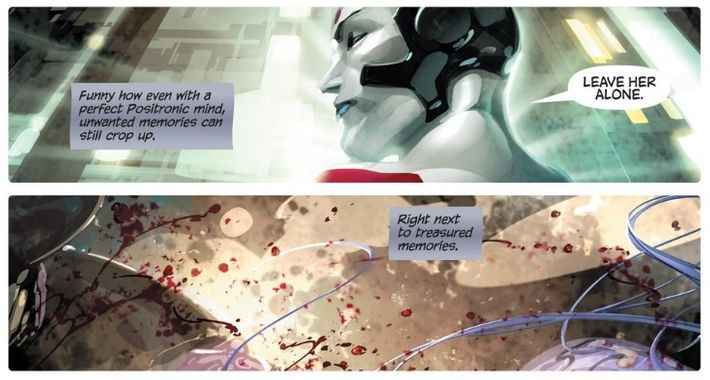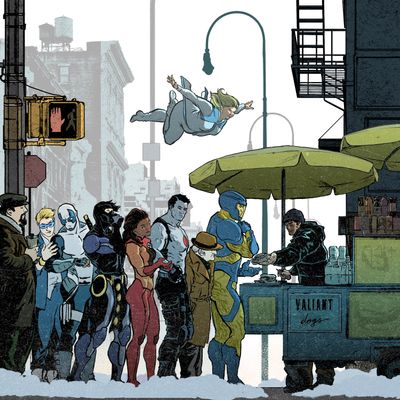
“I was sick of superheroes,” comics writer Matt Kindt told me as he sipped his coffee at a midtown Manhattan café. In 2012, he was doing contract work for superhero giant DC Comics and chafing under its tight creative controls. But in the midst of his caped-crusader fatigue, his brother called him with some bizarre news: “He’s like, ‘Hey, do you know Valiant is back?’”
As a kid, Kindt had been a fan of Valiant Comics. Founded in 1989, it became the first credible threat to Marvel and DC — the so-called Big Two — in decades. Series with delightfully ‘90s-style titles like Bloodshot, Harbinger, and Ninjak boasted massive sales and critical acclaim. For a short while, Valiant was the third-biggest company in the industry. Then it collapsed. In 2004, after years of irrelevance, it formally dissolved. Its superheroes became historical footnotes.
So you can forgive Kindt for being baffled to hear Valiant was, in any form, “back.” He quickly learned that his old favorite characters had their own books again, with completely rebooted stories made by all-new creative teams. “I was reading Bloodshot and Harbinger again, and I was like, Wow, this is good!” Kindt said. “I guess I don’t hate superheroes. I just hate the kind of superhero books that are usually out.”
Today Kindt isn’t just a fan — he’s one of the company’s star writers. He’s participating in one of the strangest experiments in comics history: the resurrection of Valiant, a brand that had long been a failure and a punch line. It’s an experiment that involves message boards, mysterious auctions, time-traveling Visigoths, filthy cubicles, and Moneyball. The goal is to create a superhero universe that can challenge Marvel and DC’s supremacy. It’s an experiment that could very well fail. But right now, against all odds, it’s working.
***
Dinesh Shamdasani wouldn’t be CEO of Valiant Entertainment today if his best friend hadn’t run a con on him.
When the original Valiant launched, Shamdasani was a child living in Hong Kong. He loved American superhero comics but didn’t know of any comics shops in which to buy them. So he had to rely on his pal Jason Kothari, whose father would go to the U.S. for business trips and bring back suitcases full of comics. Jason used those shipments the way a drug kingpin might use imports of cocaine.
“Jason — and I should’ve known he was going to be a consummate businessman at that point — picked out the ones that he thought would be worth the least amount of money and would give them to his friends who didn’t read comics, one each,” Shamdasani told me at Valiant’s cramped midtown offices. “So this is the one I got, this Valiant comic, X-O Manowar No. 6.”
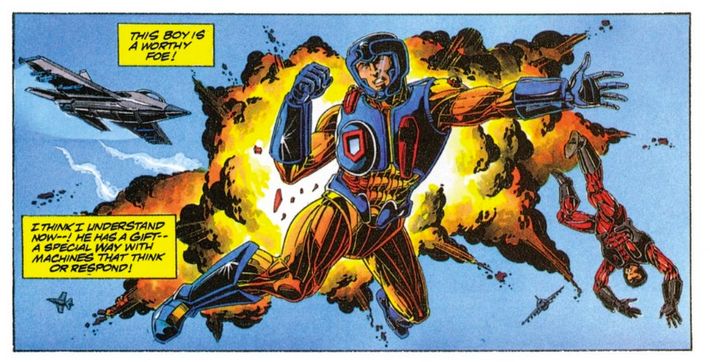
If that name sounds preposterous, don’t worry: The concept behind it was even weirder. The series was about a fifth-century Visigoth who gets abducted by aliens, steals some mystical sentient armor, and lands on Earth in the present day (to be specific, 1992). The issue Kothari pawned off on his gullible friend is a delightfully dated example of early-’90s superhero writing: The hero and a whiz-kid teen, each dressed in robot suits, beat each other up while the former spouts overwrought battle cries (“Ho! Your servants offer little sport, boy! Let’s see if you fare better!”) and the latter dishes out hip slang (“Wow! That armor is totally rockin’!”).
This kind of stuff was a license to print money back in 1992. Indeed, when Shamdasani started reading Valiant comics, the company was the industry’s biggest success story. The brainchild of Marvel defectors Jim Shooter and Bob Layton, Valiant formed in 1989 and started out with stories about forgotten superheroes whose copyrights it had licensed. Only in 1992 did Valiant begin publishing series with all-new characters.
Those series were abrupt game-changers for the comics industry, and they all had marvelously strange premises. There was Rai, about a samurai who protects 41st-century Japan (which is a country-size satellite floating in space). There was Bloodshot, about a former mob hit man with nanite microcomputers swimming in his blood. There was Archer & Armstrong, about a Christian zealot and an immortal alcoholic who go on wacky adventures. To make things even more enticing for fans, all of these stories took place in the same universe, with characters popping in and out of each other’s series.
By the end of 1992, industry trade magazine Wizard reported that seven of the ten best-selling comics of December were Valiant series. By the end of 1993, Valiant had two of the top 10 best-selling series of the year, and five in the top 50. Just two years after launching their original superhero line, they had roughly half of DC’s market share. The Valiant Era was in full swing.
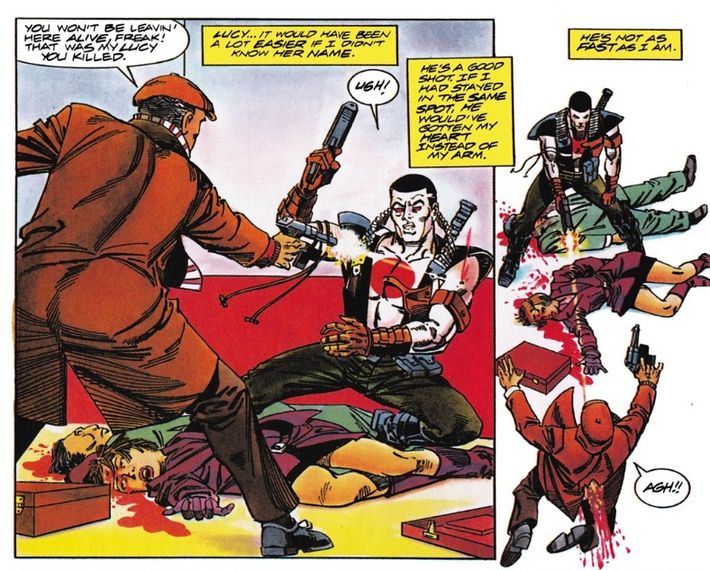
But it wouldn’t last. Valiant had helped inflate a now-infamous speculators’ bubble in the comics industry. Every month brought more silly promotional schemes from Marvel, DC, Image, and Valiant: Readers were told to collect and resell “special edition” printings of issues, “collectors’ edition” issues were held up as an investment item, and comics shops popped up all over the U.S. just to cash in on the trend. The bubble slowly burst and the industry fell into a horrible slump in the late ’90s. Valiant’s investors sold it to a video-game company called Acclaim. There was a failed attempt at a reboot in 1996. Scattered issues trickled out until 2002, when publication ceased. Acclaim went defunct in 2004.
And so it seemed Valiant was destined to be a distant memory, an exemplar of the comics industry’s insane ’90s excess. But the imprint wasn’t dead. Like Captain America, it had merely been lost and frozen, ready for someone to fish it out and defrost it.
***
Valiant’s rebirth, nerdily enough, began on a message board. In 2004, Shamdasani had long since left Hong Kong for the sunnier shores of Southern California. In the real world, he was an unhappy 23-year-old with an executive job at Universal Pictures. But online, he thrived as an active member of the ValiantFans.com message board, where dedicated geeks kept the flame alive.
When Acclaim went belly-up, the board lit up. All of a sudden, their beloved Valiant characters were up for grabs. Shamdasani read a rumor that the animation studio Film Roman had bought Valiant’s intellectual property for a meager $50,000.
“I was so pissed off, because — I mean, $50,000? It’s worth way more than that!” Shamdasani told me. “I’m like, X-0 Manowar alone is worth more than that! I was so angry. Not that I had $50,000, but come hell or high water I was going to get it, if I had the chance.”
If you meet Shamdasani, that kind of audacity — I may not know how to do this, but I’ll make it happen anyway — is easy to see right away. In an industry dominated by executives who sound like newspaper publishers or comic-shop clerks, Shamdasani sounds like the head of a tech start-up. He’s quiet and openhearted, but he speaks in charismatic sound bites. He’s benevolent enough to be beloved by his employees but arrogant enough to think he can upend an industry to which he’s a newcomer.
As it turned out, Film Roman hadn’t snatched up Valiant’s I.P. There was going to be an auction. Shamdasani had a shot. He and his old buddy Kothari raised some cash, came in second, watched the winner back out, and made a play for the prize — only to find an anonymous party had made a copyright claim on the characters.
Shamdasani quit his job and devoted the next two years to a bare-knuckle legal fight with that mysterious party. It nearly destroyed his finances, but he says he felt a kind of duty to soldier on. “I knew that if I didn’t do this, Marvel, DC, Time Warner, Sony, Disney — they’re not gonna come in, because the rights were too fragmented,” he recalled. “If we didn’t do it, I would never see another Valiant comic in my life. I could kiss that good-bye. And that was just a sad scenario for the world.”
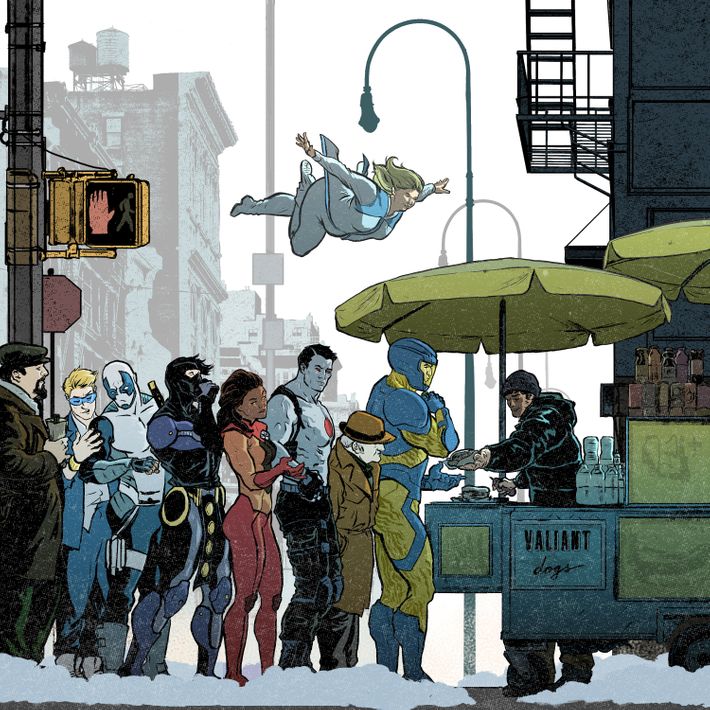
Incredibly, Shamdasani and Kothari won. In 2007, they established Valiant Entertainment and installed themselves at the helm. They had zero knowledge of the comics business. They brought controversial Valiant co-founder Jim Shooter onboard, but his notoriously bad disposition crippled the business relationship after a few months. That’s when the boys from Hong Kong delved into the most sacred of 21st-century business texts.
“Lot of sports fans in the office; everyone understands Moneyball,” Shamdasani said, referring to Michael Lewis’s 2003 best-seller about the Oakland Athletics’ strategy of building a successful baseball team out of cheap-but-great players. They’d recruited a veteran Marvel editor named Warren Simons, and Simons went on the hunt for people he thought were undervalued by Marvel and DC. “We just started to pick up these pieces, and no one’s looking,” Shamdasani recalled. “It was crazy: Why are people not using them?”
First came a crop of editors and executives who left Marvel after Disney bought it in 2009. Ever the salesman and fanboy, Shamdasani persuaded them that Valiant could offer more creative freedom than they’d ever had. Then came the creators. The early artist and writer recruits — people like Robert Venditti, Josh Dysart, Patrick Zircher, and Clayton Henry — weren’t household names, and they’d been slaving away at Marvel and DC.
Valiant couldn’t offer them enormous sums of money, but it could promise that they’d be huge fish in a small pond — and that they could build a universe. Ultimately, that was the Valiant dream: to create a streamlined, fully realized, company-wide superhero universe. For decades, only Marvel and DC had those kinds of universes. Valiant wanted to overthrow the two-party system.
***
In pursuit of that goal, the new Valiant busted out the old Valiant’s love of self-important bluster and gimmicks. It’s worked on branded skateboards and pint glasses, custom downloadable emoji and collectible leggings. But it’s especially into selling its creative decisions as events.
That’s been true since day one. In the early months of 2012, the company made a publicity and advertising blitz promoting what it called “The Summer of Valiant.” Starting with the first issue of the new X-O Manowar on May 2, the company would debut a new, rebooted series every month until summer’s end: Harbinger, Bloodshot, then Archer & Armstrong.
The premises of each title hewed closely to their ’90s namesakes across the board. X-O starred a time-displaced Visigoth; Harbinger was about disaffected teens with powers they didn’t understand; and although Bloodshot’s hero was now a former soldier instead of a former mob hit man, he still had those nanite computers in his blood, sheet-white skin, and a talent for holding large guns.
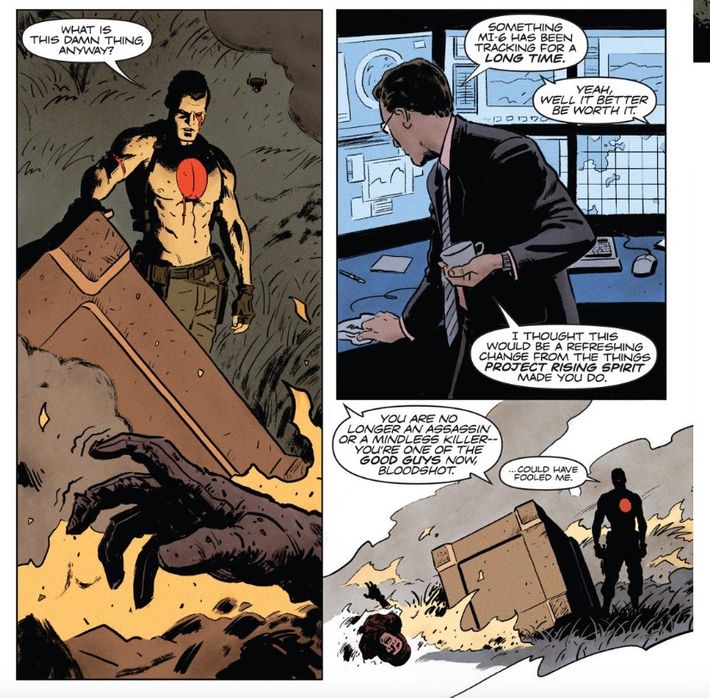
But beyond that, the creators were completely liberated from the past. Unlike all of Marvel and DC’s titles, you needed zero prior knowledge of the Valiant universe to get these characters because the universe had been completely rebooted.
Astoundingly, the Summer of Valiant campaign worked. X-O Manowar No. 1 sold more than 42,000 copies, making it the second-biggest-selling independent comic of the month (the first, as is always true, was Image’s The Walking Dead). The other debuts were all among the top three indie comics of their respective months. For a brand that hadn’t put out a comic in a decade, those numbers were incredible.
What’s more, the comics press ate it up. “It has to be said, as someone who read and loved the original X-O Manowar series: this is better,” IGN wrote in its review of the first issue. Comic Book Resources said Harbinger No. 1 was “exciting and feels new in a way that few comics about characters with superpowers manage these days.” The reviewers seemed as surprised as they were delighted.
And it was all so earnest. There was no cynical self-referentiality or weariness in the Valiant titles. It was like the difference between a big-budget horror movie that’s been watered down by studio rewrites and an indie horror flick by a director who just wants to write a scary story like the ones he grew up watching.
For example, Bloodshot wasn’t a parody of an action-hero story or a radical reimagining of an action-hero story: It was just an action-hero story. Take this scene from Bloodshot No. 10: The titular hero is trying to rescue some superpowered kids from Project Rising Spirit, a shadowy paramilitary organization:
“Down! Now!” screams one of Rising Spirit’s goons, shaking his rifle at Bloodshot.
“Well, buddy, you’ve just stepped into someone else’s war,” Bloodshot counters, his brow furrowed and unafraid. “If I were you, I’d run back to your choppers and fly away as fast as you can.”
“You want to know who we are?” the goon says. “We’re the guys who don’t give a #$@$.” He shoots Bloodshot four times in the chest. But our hero doesn’t fall.
“Seriously,” Bloodshot says, bleeding but healing. “Run.”
Even Valiant’s more lighthearted series, like Archer & Armstrong and Quantum & Woody (which debuted in 2013), have a charming lack of shame. There are no fourth-wall-breaking winks at the silliness of superhero stories — something that funny Marvel and DC titles like Deadpool, Hawkeye, or New Suicide Squad constantly use. When Archer and Armstrong fought a secret society of Nazi Buddhist monks in their first story arc, it wasn’t an in-joke about anything; it was just a fun, odd premise.
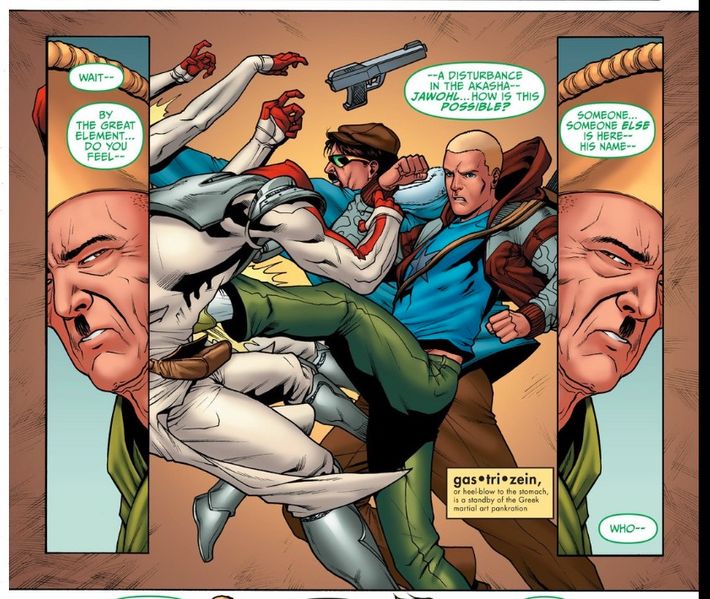
And perhaps most important, Valiant is dependable. As of this month, it’s put out 18 different comics series, comprising 202 individual comics issues, and every single one of them has shipped on time — something unheard of for the Big Two. Valiant tries to offer comics that match any potential reader’s preferences: There are team books, solo books, sci-fi books, supernatural books, and so on.
“I know when I pick up a Valiant book I’m going to get my $3.99’s worth out of the story,” Dan Pittman, a longtime comics reader, told me. “I think [there’s] a focus more on just the comics themselves and less on marketing pushes for movies and big events and other things that DC and Marvel are guilty of.”
However, he thinks Valiant still has a big hurdle to overcome: “The only knock I have against them right now is the lack of diversity that is cropping up in their line, both in terms of characters and the creatives behind them.” He has a point: Few of its titles star women (and the ones that do are either team books or limited series), and its creative staff is overwhelmingly male.
Even Kindt, who’s currently writing three Valiant series, thinks his company has catching up to do on diversity. He recalled going to his first Valiant writers’ retreat, which was “maybe six or seven guys, and the first thing we said was, ‘We need to get a woman in here, it’s ridiculous.’”
Shamdasani agrees that gender diversity is a concern. “We don’t have an equal split of male and female creatives or male and female talent [in the comics industry],” he said. “And I think because certain publishers are owned by large corporations, there are certain demands on them from an optics point of view. They value more highly female talent, and so they pay more for female talent, and they more aggressively court them. So it’s been very difficult.”
Whatever Valiant’s future looks like behind the scenes, its output is certainly getting artistically diverse. Although Valiant continuity is easy to follow, the company’s storytelling is getting more ambitiously weird. This year saw the relaunch of Rai (which is somehow even more insane and high-concept than its ’90s predecessor), and next year we’ll get Ninjak, which will be told in multiple time periods simultaneously. And in a very coming-of-age move, it’s launching a series about an all-new character with no ’90s counterpart: Divinity, starring a lost Soviet cosmonaut who returns to Earth with godlike powers.
Valiant may still lag behind the Big Two in sales, but Shamdasani says he’s playing the long game. Standing in his office, surrounded by the piles of documents and comics that litter his train wreck of a desk space, he told me his ambition: “Being the third-biggest publisher in the business is our goal. Hopefully in five, ten years, whatever it takes, we’ll get there.”
“We have yet to have a big flop,” he said, beaming. “It’ll come. I’m sure it’ll come. But it hasn’t come yet.”
